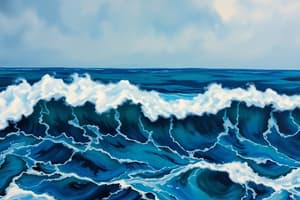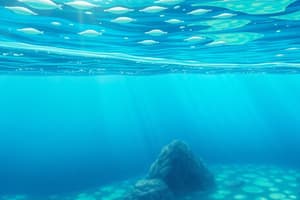Podcast
Questions and Answers
How does thermohaline circulation work?
How does thermohaline circulation work?
Thermohaline circulation is a worldwide current system in which the warmer, fresher water moves along the surface while the colder, saltier water moves beneath it. It is driven by the downwelling of cold salty water at the poles and the movement of warmer fresher water on the surface by wind and waves.
Which properties of water and which forces help to overturn the ocean?
Which properties of water and which forces help to overturn the ocean?
Temperature and salinity.
What are the primary ocean layers, and why are the layers separate?
What are the primary ocean layers, and why are the layers separate?
They are mixed, thermocline, and deep ocean, separated by temperature and salinity.
How long does this process take?
How long does this process take?
Where do the branches connect with the entire ocean?
Where do the branches connect with the entire ocean?
How does thermohaline circulation affect the climate?
How does thermohaline circulation affect the climate?
What could happen to thermohaline circulation because of global warming?
What could happen to thermohaline circulation because of global warming?
Flashcards are hidden until you start studying
Study Notes
Thermohaline Circulation Overview
- Thermohaline circulation is a global current system driven by temperature (thermo) and salinity (haline).
- Warmer, fresher water flows near the surface, while colder, saltier water moves below.
- The process starts with the downwelling of cold, salty water at the poles, and surface currents are influenced by wind and waves.
Key Water Properties and Forces
- Temperature and salinity are critical properties that drive ocean overturning.
- Variations in these properties create density differences, influencing water movement.
Ocean Layers
- The ocean has three primary layers: mixed layer, thermocline, and deep ocean.
- These layers are separated due to differences in temperature and salinity, causing stratification.
Timeframe of Circulation
- The complete cycle of thermohaline circulation takes approximately 1,000 years to complete.
Connection Points in the Ocean
- The branches of thermohaline circulation connect with the entire ocean system primarily at the polar regions.
Climate Regulation
- Thermohaline circulation plays a vital role in energy transport, influencing global climate and temperature regulation.
Impact of Global Warming
- Global warming poses a risk to thermohaline circulation by potentially preventing cold water from downwelling.
- Past events, like the melting of the North American ice cap, have caused similar shutdowns, as indicated by Greenland ice core data.
Studying That Suits You
Use AI to generate personalized quizzes and flashcards to suit your learning preferences.





